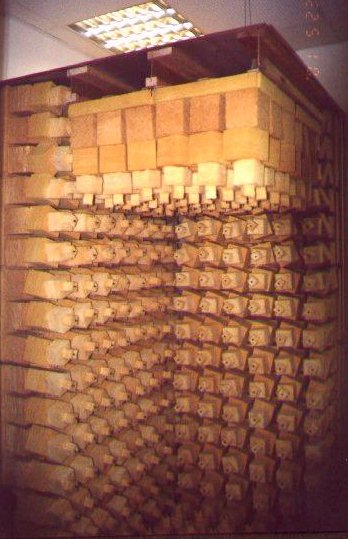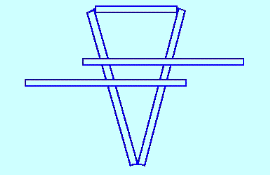

Brüel Acoustics
Anecho Test Facilities: 62BA and
62BB
Brüel Acoustics have developed two modular Anecho Test Rooms for
industrial research, acoustical measurements and
calibration.
The test chamber is a light construction named
type 62BA (modul 40 cm) and the system for larger rooms
type 62BB (modul 60 cm).
The modular system makes use of a
1imited number of standard elements which can be connected together and form
more than 100 rooms with different lenght, weight and height.
On a given
space all dimensions can be made by choosing the nearest number of moduls.
The price for the rooms are proportional to the element units.
Wedges are normally build of the same material both at the bottom and the
top. In the loudspeaker analogy this correspond to a linear cone in front of the
driver.
Consequently the Cremer room is much better at high
frequencies than a Wedge room of the same size.
At mid frequencies
the two types are equel, and at low frequencies the Wedge type is normally
slightly better.
From an economical point of view it can be said that a
Wedge room contains more absorbing material than a Cremer room, but a Cremer
room requires more sophisticated work which means higher labour cost.
At
B&K we used only Cremer type rooms because it is very important that
the room is good at higher frequencies up to 15 kHz.
The lower
frequencies below 300 Hz are not so important as the wavelength is large so that
other methods can be used.
With frequencies over 3 kHz a Wedge room will
always give some uncontrollable fase shifts because the Wedges
have large plane surfaces whereas the Cremer rooms have an acoustical jungle.

Construction:
Both Cremer
types are built of tubes where no plane surfaces exist.
Consequently
all reflections are minimized in all directions.
Most of the
supporting structure is imbedded in the absorbing material.
Type 62BA have a modul length of 40 cm and also a wall
thickness of 40 cm. Supporting tubes have a diameter of 10 mm.
This room
works very accurately from 350 Hz to 25 kHz depending of the
size.
Type 62BB has a modul length and a wall thickness of
60 cm and is intented for bigger rooms and working frequencies from 200
Hz to 20 kHz.
Both rooms should be erected on a plane smooth surface
e.g. reinforced concrete or very hard wood.
A concrete slab are ideal and can conveniently be supported by steel springs for vibration isolation.
Floors:
Both types can work
with and without an absorbing floor and therefore satisfy all standards in force
today.
The absorbing floor consists of easy removable units.
It takes
only a few minutes to remove the floor.
It is therefore important that the
base reflects the sound and is plane.
Doors:
The door can consist of
one or two units in width and two, three, or four units in height.
The door
itself consists of units which like the floor fits in the normal wall units.
The door is rolling out perpendicular to the wall.
When it is out, it is
rolled parallel sidewards.
This movement is done on rails with roller
bearings.
How much space is needed?:
The rooms can be erected from the "inside" and therefore the
space required is only 5 to 10 cm space between testroom and fixed building.
But remember the test rooms can only be delivered in units of 60 or 40 cm.
The space from the wall where the door is installed has to be the wall
tickness (60 or 40 cm) + 10 cm.
This small space is minimum.
The
erection is faster and easier if more space is available.
Ventilation:
Air should not be
blown into the test room.
Heavy draught will break some of the glass fibres
and produce dust. But the air around the room can be airconditioned without
problems.
Lisht and Electric Cables are easily installed in a Cremer room as there is a
lot of space in the absorbing walls.
It is very easy to change the cables.
